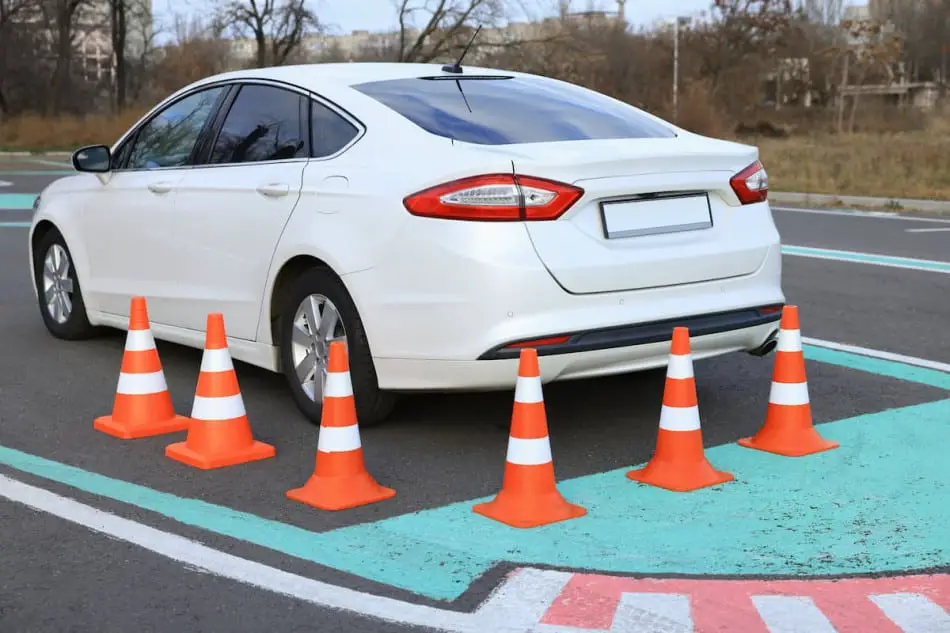Driving is a privilege that comes with a great deal of responsibility. Before you sit behind the wheel of a few tons of steel, there are many things to learn, which keep you, your passengers, and other drivers on the road safe. But what do you do if you want to learn on your own?
Here’s how to legally teach yourself to drive a car:
- Research your state’s laws.
- Take an online driving course.
- Get a learner’s permit.
- Request your state’s driver’s handbook.
- Watch YouTube videos.
- Ask for help from a legal driver.
- Watch someone drive.
- Take online practice tests.
- Practice!
Whether you want to drive occasionally or you need a license to drive every day, you’ll want to stick around for the rest of this article. You’ll learn what the laws are, how to get your learner’s permit, and more.

1. Research Your State’s Laws
While many laws are consistent across the country, not all of them are the same. Your state has its own regulations to follow, including whether you need a permit to get behind the wheel, the age you can drive, and what rules have to be followed while behind the wheel.
If you get pulled over, claiming ignorance won’t get you out of it. The best thing you can do is visit your local DMV website.
There you will find:
- State regulations
- Driving ages
- A plan to move forward with getting your driver’s license.
- What laws to follow in order to practice, such as what you can do with and without a permit.
All state websites have information about learning how to drive.
Pay special attention to the age requirements when you choose to skip an official class. Some states require that you attend a class if you are under the age of 18 or 21 or get a set amount of practice hours alongside a legal driver.
2. Take an Online Driving Course
Knowing how to drive is only part of the process of learning to be responsible on the road.
Being aware of what your state demands of you as a driver are crucial. For example, what do you do if you are going down the highway and see a police officer parked on the side of the road with their lights flashing?
Do you know how to keep yourself safe if you hydroplane?
Some of these lessons are legal, but others are a matter of personal and public safety. This is where online courses come in, as you can learn everything you need to know from the comfort of your home, in your own time.
You never have to step foot in a classroom.
Keep in mind that not all online courses are created equal. Your state DMV should have a list of approved online driver’s ed classes and schools that they recommend you use.
In some regions, they may use one of these programs as proof of readiness to drive. In most cases, it is a personal decision to take one and will help you on your written and practical exams when you get your official documentation.
If you can’t find a page on their website with a list, give them a quick call to ask if they have any preferred programs.

3. Get a Learner’s Permit
This is probably the easiest route, mainly if you are underage.
A learner’s permit gives you legal permission to drive, though not on your own. In most states, if you have a learner’s permit, you can drive on public streets while next to a licensed driver who can monitor you.
It is an excellent way to practice your driving and get comfortable with driving in all circumstances.
Different agencies have their own requirements for obtaining a permit. They will also vary in age, with some being as low as 14-years-old, and some 15-years-old. If you are under the age of 18, you will be required to have a parental signature at the time of application, as well as that of a driver’s ed instructor.
When you have a learner’s permit, you are accepting the responsibility of being able to drive.
That means the penalties for misbehavior or unsafe driving will be severe. There have been cases of young people getting tickets on a learner’s permit and losing their ability to get their license until they come of legal age.
Don’t take any chances, or you could end up paying a steep price.
4. Request Your State’s Driver’s Handbook
Your state will have a handbook that gives you everything you need to stay safe while operating a vehicle and pass your written test. Some have physical books you can order or pick up at the DMV.
Others provide an online version that can be downloaded in PDF form so you can have it on any device.
Keeping this handbook handy is a great idea. You’ll get to know the laws, get some great tips and discover things you may not have known about driving. Just make sure it is the most recent addition, as laws can change.
5. Watch YouTube Videos
This may be the best tool you have at your disposal when it comes to teaching yourself to drive: YouTube.
There’s an incredible number of channels out there dedicated to showing you the ins and outs of hitting that highway, including tutorials. Some are state-specific, and your state may have an official channel related to your region, while others are more general.

Let’s look at some to get you started.
Helpful DIY
This video is a complete rundown of how to drive, from the second you put the keys in the ignition to when you remove it at your destination.
He assumes you know absolutely nothing beyond what a car is, which is more helpful than you might think. He goes over what you need to do to drive, what to look out for, the different features of a car that you will end up using (windshield wipers, blinker, headlights), and more.
Are you scared to drive? He has a video for that, too.
Driving TV
Another driving beginner video, this one shows the car from different angles, including the wheel.
This gives you a complete view of what is being done, so you can feel more confident when you mimic it yourself later on. It isn’t quite as thorough in some ways, but if you are nervous about taking that first drive, this is a great tutorial to put you at ease.
Also, check out this video with tips for new drivers.
Road Test Success
Not sure what to expect from the driving test itself? This is a dashcam video with audio of a driving test so you can see what the process is like and prepare accordingly.
Keep in mind that not all tests will be the same, and your state may have different requirements or ways of doing things. But it is a fantastic general view of the exam that might reduce that anxiety a bit.
Bright Side
Want to be even more prepared? This video goes over some tips and tricks that aren’t generally known or taught in driving schools.
Please remember that these are not “official” and might not always apply to your area. But they seem to be pretty general and great things to know, such as being aware of how your vehicle operates and what that really means.
ParkingTutorial
Everyone has heard the horror stories about parallel parking, right? This video demonstrates what has to be the easiest possible method for getting it right, so you can pass it when you take your test.
The channel also has other parking tips, which are all very important. After all, parking is a skill that some people never properly learn, as evidenced by some of the terrible examples you can see in any parking lot.
Smart Drive Test
Everyone gets nervous when they take their test. What if something goes wrong? Avoid the most common mistakes people make with this video by Smart Drive Test. Once you know what people do to fail, you can reduce the risk of following in their footsteps.
6. Ask for Help From a Legal Driver
It doesn’t matter if you are actually driving or just learning what you need to know, having someone who has already been through the process is the perfect way to gain knowledge and get support.
Whether it is a relative or friend, having some advice and being a cheerleader as you go through this milestone is a critical part of being successful.

This may also be legally necessary to start taking your skills into the real world to put them to the test. Most states demand you have a licensed driver in the car any time you get behind the steering wheel until you have an official license yourself.
They aren’t just being harsh, as driving solo can be risky when you are just getting started.
Consider putting together a group of dedicated individuals who are eager to see you succeed and willing to help. Set a schedule for practicing, both for your written and practical tests. Have them ask questions, run flashcards and do anything else they can do to ensure you are ready when the time comes to strut your stuff.
7. Watch Someone Drive
Before you ever try driving yourself, you should watch someone else do it. That doesn’t mean glancing over while your mom drops you off at the movies. Study what is happening and ask questions.
Have them explain:
- What they are looking at.
- How they check their mirrors.
- When to turn on their turn signal when you start breaking.
- When to accelerate.
It may seem like a lot, but the more they drill the routine into your head, the easier it will come to you when it is time to try yourself. You may also find it more enlightening than a class or handbook alone. This gives you the chance to see it all in practice, not only in theory.
8. Take Online Practice Tests
There is no way to be 100% prepared to take the written test since you won’t be sure of exactly what will be on there. You can be confident about the availability of all of the info you need, which will be in the state handbook.
All questions come from there, and so studying is critical if you want to pass.
Want another leg up? Try a practice test! Your DMV might have practice tests on their website that you can use or links to officially sanctioned ones that can get you ready. A Google search will bring up others that are specific to your area.
Just keep in mind that if the DMV doesn’t recommend it, you cannot be sure those tests will be accurate or based on the most recent changes to local laws.
Double-check the handbook to make sure your test is accurate. Then use that test as a guideline to make sure you know your stuff and are all set to crush that written test. If you find yourself lost on a specific point, you can always contact your local DMV for clarification prior to your test date.
9. Practice!
This is one of the most essential tips for teaching yourself how to drive, as you need a lot of practice.
Not only will you feel more comfortable operating a car if you have plenty of time under your belt, but it also makes certain acts automatic. If you check your mirror deliberately a hundred times, that hundred and one should happen without thinking.
You should always make sure your practice is done legally.

In some states, you can drive in a parking lot without a permit if you have a licensed driver with you. In others, you can only do that on private property that you own. In still others, you will not be getting behind the wheel without a permit in hand.
Once you are legally able to drive, you will be able to put in as many hours as are required to satisfy both you and the state.
Final Thoughts
Teaching yourself to drive is possible. But you have to follow your local laws and do so safely. That means knowing the rules of the road and having the right tools at your disposal. The above should get you started. Drive safe!





